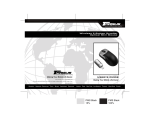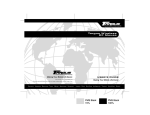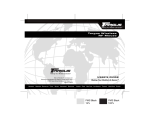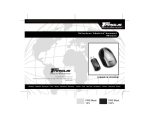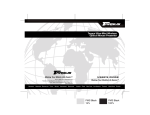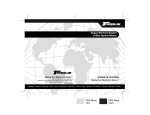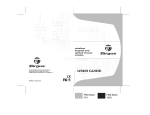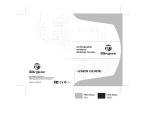Download Targus 400-0088-001A Mouse User Manual
Transcript
Screen Scroller Mouse Making Your Mobile Life Easier. USER’S GUIDE Visit our Web site at: www.targus.com Making Your Mobile Life Easier. Features and specifications are subject to change without notice. © 2002 Targus Corp. 400-0088-001A BRUSSELS HANNOVER BARCELONA TOKYO MILANO AMSTERDAM SINGAPORE LONDON PARIS NEW YORK LOS ANGELES TORONTO HONG KONG SYDNEY Screen Scroller Mouse Introduction Congratulations on your purchase of a Screen Scroller Mouse. The scroll feature of this ergonomically designed mouse enhances your internet browsing capabilities and enables you to quickly access program features options supported under the Windows® operating system. NOTE: If you are running the Macintosh operating system, the Screen Scroller Mouse emulates a one button mouse. The mouse connects directly to your computer’s USB port. Alternatively, if you are using the Windows® operating system, you can use the supplied PS/2 adapter to connect the mouse to your computer’s PS/2 port. This user’s guide describes how to connect the mouse to your computer, install the default device drivers and personalize the mouse features for the following mouse models: • PAUM002 v2 – Targus Mini Screen Scroller Mouse • PAUM003 v2 – Targus Optical Mini Screen Scroller Mouse • NW03BM – Targus Noteworthy Desktop Optical Screen Scroller Mouse • NW04MM – Targus Noteworthy Optical Screen Scroller Mini Mouse 2 System Requirements To use the mouse, your computer must meet the following hardware requirements and run one of the operating systems listed below. Hardware Operating System • PC with a Intel® Pentium® processor • or equivalent and a hard disk drive • 64 MB RAM or higher, depending on • the operating system • USB version 1.1 interface • or PS/2 port Windows® 98/Me/ 2000/XP Windows NT® (PS/2 only) Mac OS X and higher (USB only) Connecting the Mouse to Your Computer Depending on the operating system you are running, you can connect the mouse to either your computer’s USB port or, using the supplied PS/2 adapter, you can connect the mouse to your computer’s PS/2 port. Connecting the Mouse to the USB Port NOTE: If you are running the Windows NT ® operating system, you must connect the mouse to your computer’s PS/2 port. See “Connecting the Mouse to the PS/2 Port.” To connect the mouse to an available USB port: 1 Turn off your computer. 2 Plug the standard USB end of the cable into an available USB port on your computer. You are now ready to install the device drivers for your operating system. 3 Connecting the Mouse to the PS/2 Port NOTE: If you are running the Macintosh operating system, the you must connect the mouse to your computer’s USB port. See “Connecting the Mouse to the USB Port.” To connect the mouse to an available PS/2 port: 1 Turn off your computer. 2 Disconnect the existing mouse, if one is attached. 3 Plug the standard USB end of the cable into the USB port on the PS/2 adapter 4 Plug the PS/2 adapter into an available PS/2 port on your computer. Screen scroller mouse and PS/2 adapter You are now ready to install the device drivers for your operating system. NOTE: Only the standard scrolling features are available when the mouse is connected to the PS/2 port. Installing the Device Drivers If the operating system you are running supports Plug and Play operation, it installs the default device drivers automatically. Otherwise, use the following procedures to install the default device drivers for your operating system. 4 Windows® 98/Me Operating Systems 1 Turn on your computer. The Add New Hardware Wizard appears. If it does not, the operating system has installed the default driver automatically. No other steps are necessary. 2 Click Next. The locate driver screen appears. 3 Select “Search for the best driver for your device. (Recommended),” and then click Next. The wizard searches for the appropriate device driver. 4 Click Next. 5 Click Finish to complete the driver installation. You are now ready to use the mouse. Windows® 2000/XP Operating Systems 1 Turn on your computer. The Found New Hardware Wizard appears. If it does not, the operating system has installed the default driver automatically. No other steps are necessary. 2 Click Next. The wizard searches for the appropriate device driver. 3 Click Next. 4 Click Finish to complete the driver installation You are now ready to use the mouse. 5 Using the Mouse The following mouse features are factory set and cannot be personalized. Feature Description Screen scroller Moves the cursor when you roll the wheel. Right button Launches the context menu and provides secondary drag functions. Horizontal scrolling Moves the cursor along the horizontal scroll bar when you press the Shift key while rolling the wheel. The left mouse button is preset as the primary button which provides click, double-click and drag functions. Maintaining the Mouse To improve the performance of your mouse, keep it free of dust and dirt by following the cleaning procedures described below. Cleaning the Mouse, Scroller Wheel and Mouse Ball 1 Unplug the USB connector from the computer or, if you are using the PS/2 adapter, turn off the computer. 2 Clean the outer surface of the mouse using a lint-free cloth and mild soap and water. 3 Clean the scroller wheel using a lint-free cloth or cotton swab and rubbing alcohol. For best results, wipe the wheel across, from side to side. NOTE: You can use adhesive tape to remove dust or lint from the scroller wheel. 6 4 Turn the mouse over and rotate the mouse ball retainer counter-clockwise until it’s loose. 5 Remove the retainer and the mouse ball. Unlocking the mouse ball retainer Removing the mouse ball 6 Clean the mouse ball and the two black rollers inside the mouse using a lint-free cloth or cotton swab and rubbing alcohol. Cleaning the mouse 7 7 Replace the mouse ball and the retainer. Turn the retainer clockwise until it is secure. 8 Plug the USB connector back into the computer’s USB port or, if you are using the PS/2 adapter, turn on the computer. Cleaning the Optical Sensor (Mouse Models PAUM003 v2, NW03BM and NW04MM) 1 Unplug the USB connector from the computer or, if you are using the PS/2 adapter, turn off the computer. 2 Using a cotton swab and mild soap and water, gently wipe the optical sensor until it is clean. Never scratch the surface of the sensor. 3 Plug the USB connector back into the computer’s USB port or, if you are using the PS/2 adapter, turn on the computer. Things to Remember Safety Measures Mouse Models PAUM003 v2, NW03BM and NW04MM If you are using an optical mouse, never point the optical sensor toward the face, particularly the eyes, to avoid possible injury. Operating Hints Mouse Models PAUM003 v2, NW03BM and NW04MM If you are using an optical mouse, for optimal performance: • Never use the mouse on a glass or mirrored surface or on black velvet as these surfaces will cause the mouse to fail temporarily. 8 • Avoid using the mouse on surfaces with repetitive patterns, such as printed magazine photographs, as this type of surface may cause the mouse to respond slowly or fail temporarily. Comfortable Usage All Mouse Models Research suggests that physical discomfort and injury to nerves, tendons, and muscles may be related to repetitive motion, an improperly set up work area, incorrect body posture, and poor work habits. To reduce the risk of injury, follow these precautions: • Stand, stretch, and move around several times every hour. • Switch hands while performing tasks. Use shortcut keys to avoid repetitive or awkward mouse movements. • Relax your shoulders and keep your elbows at your sides. Adjust the keyboard’s position so that you don’t have to stretch to reach it. • Adjust your position so that you don’t have to bend your wrists to type; avoid placing your wrists on a sharp edge. If you feel discomfort or numbness in your hands, wrists, arms, shoulders, neck, or back while typing, consult a qualified medical professional. Technical Support In the unlikely event that you encounter a problem with your Targus accessory, please contact our technical support team at: Email: [email protected] Internet: http://www.targus.com/support.asp Our knowledgeable staff is also available to answer your questions through one of the following telephone numbers. 9 US Monday through Friday, 8:00 a.m. (08:00) to 8:00 p.m. (20:00) Eastern time: 800-283-6325 Canada Monday through Friday, 9:00 a.m. (09:00) to 5:00 p.m. (17:00) Eastern time: 888-827-4877 Europe Belgium Denmark France Germany Italy Netherlands Spain Sweden Switzerland United Kingdom Eastern Europe & others +32 0 02-717-2451 +45 0 35-25-8751 +33 0 1-64-53-9151 +49 0 21-16-579-1151 +39 0 24-827-1151 +31 0 53-484-9470 +34 0 91-745-6221 +46 0 8-751-4058 +41 0 1-212-0007 +44 0 20-7744-0330 +31 0 53-484-9479 Product Registration For more efficient customer service and to activate the product’s warranty, Targus recommends that you register your Targus accessory shortly after purchasing it. To register your Targus accessory, go to: http://www.targus.com/registration.asp You will need to provide your full name, email address, phone number, and company information (if applicable). Warranty Targus warrants this product to be free from defects in materials and workmanship for one year. If your Targus accessory is found to be defective within that time, we will promptly repair or replace it. This warranty does not cover accidental damage, wear and tear, or consequential or incidental loss. Under no conditions is Targus liable for 10 loss of, or damage to a computer; nor loss of, or damage to, programs, records, or data; nor any consequential or incidental damages, even if Targus has been informed of their possibility. This warranty does not affect your statutory rights. Warranty Registration at: http://www.targus.com/registration.asp Regulatory Compliance This device complies with Part 15 of the FCC Rules. Operation is subject to the following two conditions: (1) This device may not cause harmful interference, and (2) This device must accept any interference received, including interference that may cause undesired operation. FCC Statement Tested to Comply This equipment has been tested and found to comply with the limits of a Class B digital device, pursuant to Part 15 of the FCC Rules. These limits are designed to provide reasonable protection against harmful interference in a residential installation. This equipment generates, uses, and can radiate radio frequency energy and if not installed and used in accordance with the instructions, may cause harmful interference to radio communications. However, there is no guarantee that interference will not occur in a particular installation. If this equipment does cause harmful interference to radio or television reception, which can be determined by turning the equipment off and on, the user is encouraged to try to correct the interference by one or more of the following measures: • Reorient or relocate the receiving antenna • Increase the separation between the equipment and receiver • Move the computer away from the receiver • Connect the equipment into an outlet on a circuit different from that to which the receiver is connected. Intel and Pentium are registered trademarks of Intel Corporation. Microsoft, IntelliMouse, Windows and Windows NT are registered trademarks of Microsoft Corporation. Macintosh is a registered trademark of Apple Computer, Inc. PS/2 is a trademark of IBM Corporation. All other trademarks are the property of their respective owners. 11











